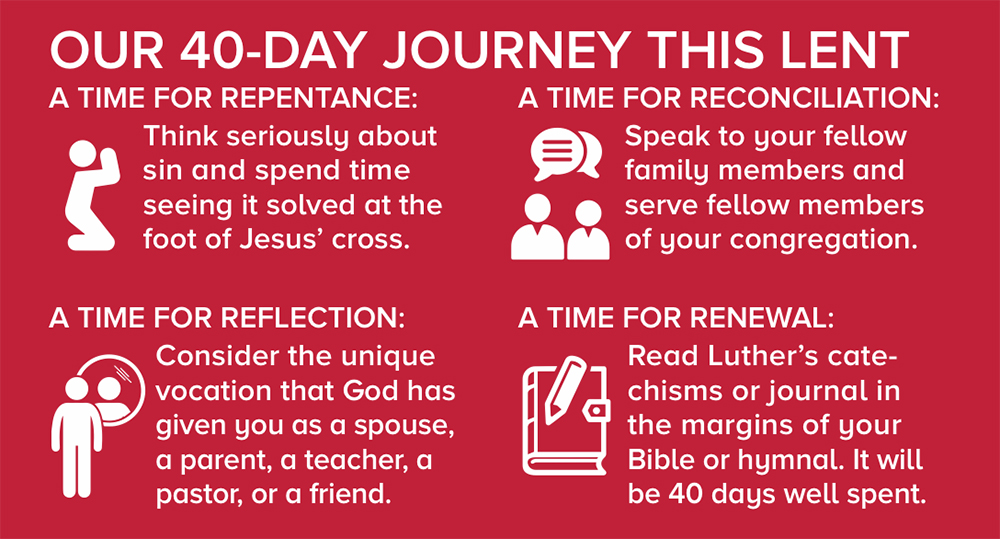 |
Lenten Bible readings and hymns remind us of God’s love and our opportunity to reflect that love.
Mark W. Tiefel
Each year, as winter yields to spring and as February turns into March, most people are ready for a change in the seasons. Especially in the north we are eager to put colder, harsher days behind us as we look forward to brighter and more cheerful days to come. Perhaps that’s why those who follow the church’s calendar might struggle with the season of Lent.
Between the bright and joyful celebrations of Epiphany and Easter, the Christian church seems to trudge its way through the 40-day journey of Lent. The journey is often marked by messages of abstinence and sacrifice and is accompanied by slow and somber hymns. For many, Lent can carry persistent feelings of guilt. We spend twice as much time in church, singing hymns that seem to take twice as long to sing. We re-examine a brutal story of suffering as we go through the Passion History.
Like the Filet-O-Fish® sandwich on the McDonald’s menu every March, everyone knows what Lent is, but no one seems to like it much. Of all the seasons, Lent seems to be the one that Lutherans love to loathe. Words like love and Lent don’t seem to fit together.
But when we look closer, we find plenty of reasons that Lent is all about love.
Love conquers all
The season, which starts on Ash Wednesday, begins a 40-day journey ending on Easter. The six Sundays in Lent, which aren’t counted in the 40-day figure, provide powerful pictures of Jesus at work. In each of them, we see the Savior waging war against all those who were opposed to him and against everything that might threaten our faith. He battles the devil and his temptations (Matthew 4:1-11; see also pp. 28,29), the Pharisees and their man-made rules (John 9:1-39), and even his own disciples when they didn’t understand the cross (Mark 8:31-38).
At the same time, we see our Savior fighting for people. He defeats the doubts of Nicodemus (John 3:1-17), the fears of the woman at the well (John 4:5-26), and the spiritual blindness of the human heart (John 9:1-39).
What drives him to do such things? Love! Love for his Father and his Word, love for his followers and their faith, love for all. Love leads Jesus to weep at the grave of Lazarus just before he overcomes the power of death (John 11:17-27,38-45). Love leads Jesus to lament over Jerusalem as he rides through the city, prepared to die for those who did not love him (Luke 20:9-19).
This is how God showed his love among us: He sent his one and only Son into the world that we might live through him.
By the time Christians reach the end of Lent, we have not only witnessed Jesus’ battles but also his bitter suffering. Many churches make use of midweek devotions to recount the Passion History. As we are reminded of the unjust brutality, what do we see at the heart of the story?
In one sense, Jesus’ “passion” relates to what he “suffered” (in Latin, passio means “to suffer or endure”). But in a greater sense, what we witness at the end of Lent is the compassionate love of Christ on full display. Lenten hymns and hymn writers love to make the connection: “What Wondrous Love Is This” (Christian Worship [CW] 120). Samuel Crossman’s poem calls us to consider it: “My song is love unknown, my Savior’s love to me, love to the loveless shown that they might lovely be” (CW 110:1). Paul Gerhard puts the truth in concrete terms: “Your cords of love, my Savior, bind me to you forever; I am no longer mine” (CW 113:5), and in the third stanza of their hymn “O Church Arise,” Keith and Kristyn Getty summarize the connection in the simplest, most straightforward terms: “Come, see the cross, where love and mercy meet.”
Each spring, while the world imagines a sentimental Valentine’s kind of love, Lent teaches the truths of God’s sacrificial and redeeming love in Jesus. “This is how God showed his love among us: He sent his one and only Son into the world that we might live through him. This is love: not that we loved God, but that he loved us and sent his Son as an atoning sacrifice for our sins” (1 John 4:9,10).
Love changes lives
 During Lent, Christians witness the love of the Savior. They also have a unique opportunity to reflect that love in their relationships with God and their neighbor. As Isaac Watts put it, “Love so amazing, so divine, demands my soul, my life, my all” (CW 125:4). The personal application of Lent’s lessons was a driving force behind many of the customs and habits associated with the season.
During Lent, Christians witness the love of the Savior. They also have a unique opportunity to reflect that love in their relationships with God and their neighbor. As Isaac Watts put it, “Love so amazing, so divine, demands my soul, my life, my all” (CW 125:4). The personal application of Lent’s lessons was a driving force behind many of the customs and habits associated with the season.
From early on, the observance of the Lenten season focused on self-examination, self-denial, and self-reflection. Lent was used by the early Christian church as an intensive study session for catechism students. Often Christians paired spiritual discipline with physical discipline. They imitated Jesus’ wilderness fasting with selective fasting of their own.
But over time, good habits became bad habits, as people focused on what and when they could eat instead of why they were choosing not to eat. Abstaining from sweets or alcohol, Wednesday soup suppers, Friday fish frys—even the famous McDonald’s sandwich—all owed their existence to Lent, even when the spiritual reasons for them were long forgotten. While many people learned to observe Lent, they certainly didn’t learn to love it!
Is it possible for us to fall in love with Lent again? Only by returning to the heart of the message will we regain the meaning of Lent. This is what we discover in a season of repentance. As we hear God’s message of pardon and absolution set forth in the gospel of our Savior, we also hear his call to continually grow in repentance and faith: “Dear friends, since God so loved us, we also ought to love one another. No one has ever seen God; but if we love one another, God lives in us and his love is made complete in us” (1 John 4:11,12).
What originally started as a Prairie Home punchline might actually serve us this season: “When you’re Lutheran, it’s always Lent.” Perhaps it’s a season that we learn to love. The stories are serious, and the hymns may be somber, but in Lent we see and share the love of God in Christ.
Author: Mark W. Tiefel
Volume 107, Number 03
Issue: March 2020







